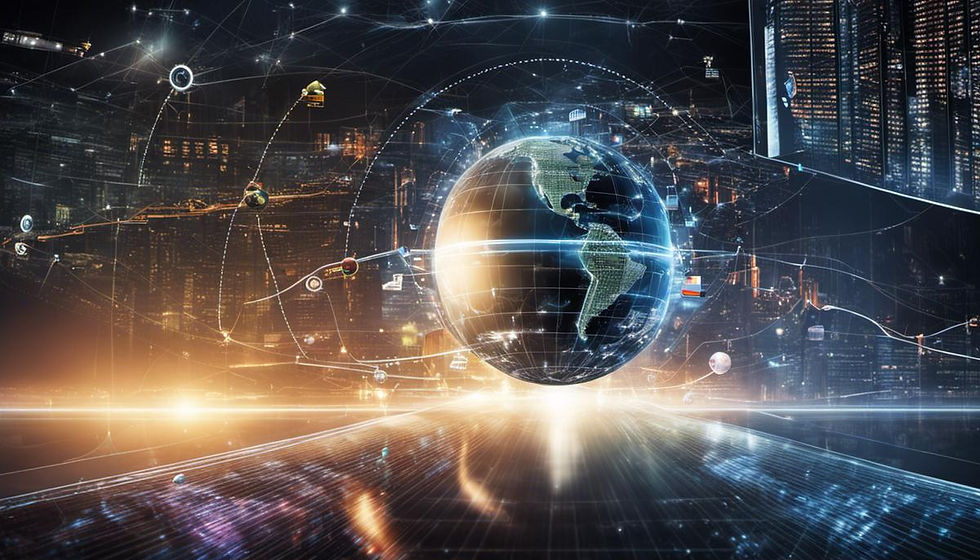
In the ever-evolving world of today, Artificial Intelligence (AI) and Predictive Analysis stand as vital game-changers across various industries. These technologies, individually impressive in their own right, prove even more formidable when combined, setting the pace for ground-breaking developments in decision-making processes. This write-up delves into the basics of AI and Predictive Analysis, casting light on their functionalities and the synergy between them. The journey continues through the evolution and impact of these innovations, painting a vivid picture of their transformative effects in sectors such as healthcare, finance, and e-commerce. It further explores the inherent advantages, coupled with the accompanying challenges of employing AI in predictive analysis, providing a balanced viewpoint of its potential impact on our world.
Understanding the Basics of AI and Predictive Analysis
Artificial Intelligence Basics
Artificial Intelligence, or AI, is an amalgamation of computer science that aims to create systems capable of performing tasks that would normally require human intelligence. These tasks could be anything from understanding natural speech to recognizing patterns to problem-solving and decision making. The idea is to create machines capable of learning and adapting through experience, much like humans, but at a much larger scale and speed.
AI can be divided into two broad types – Narrow AI that is designed to perform a narrow task (such as facial recognition or internet searches) and general AI that can perform any intellectual task that a human can. Every AI system is powered by underlying algorithms that help the system learn and evolve over time.
Predictive Analysis 101
Moving on from AI, let's delve toward Predictive Analysis. Predictive analysis involves the use of data, statistical algorithms, and machine learning techniques to identify future outcomes based on historical data. It’s all about providing a best assessment of what will happen in the future. It uses a multitude of techniques from data mining, statistics, modeling, machine learning, and artificial intelligence to analyze current data and make predictions about the future.
The Connective Threads of AI and Predictive Analysis
When we talk about Predictive Analysis using AI, it's about combining the concept of forecasting future outcomes, with machine learning and AI, with the objective of enhancing the accuracy of predictions. Predictive models use known results to develop (or train) a model that can be used to predict values for different or new data.
The modeling provides results in the form of predictions that represent a probability of the target variable based on estimated significance from a set of input variables. In AI, these inputs could be enormous amounts of data from diverse sources, structured and unstructured. They can be derived from browsing data, purchase data, social media activity, or client interaction transcripts, and many more.
Algorithms feed on this data to recognize complex patterns, understand them and learn from them. The more high-quality input data available, the more accurate the predictions.
Unlocking Future Insights with AI-Powered Predictive Analysis
As society becomes ever more digitized, industries ranging from healthcare to finance, from marketing to sports, are harnessing the power of Artificial Intelligence (AI) for predictive analysis in their decision-making processes. In the realm of healthcare, for instance, predictive analysis can forecast potential epidemic outbreaks, while in the financial sector it plays a key role in deciding credit scores. Within marketing, it's all about predicting consumer behavior and future buying trends.
Large companies like Netflix and Amazon are no stranger to the usage of predictive analytics. Netflix, the international streaming service, uses this technology to recommend shows to its subscribers based on their earlier viewing preferences and habits of other close-matching users. Similarly, Amazon employs AI to anticipate the products their customers may prefer in the future, offering them personalized product suggestions.
By melding Artificial Intelligence and Predictive Analysis, businesses are gaining a window into the future. It enhances their ability to forecast results and devise their business strategies in a more knowledgeable manner. The higher the prediction's accuracy, the greater the potential benefits for all users, including individuals, corporations, and the general public. This fusion of technologies is enabling industries to make critical preemptive moves backed by insightful choices.

The Evolution and Impact of Predictive Analysis Using AI
The Evolution of Predictive Analysis Powered by AI
Both Artificial Intelligence (AI) and Machine Learning (ML) have come a long way since their genesis. The term 'Artificial Intelligence' made its debut at Dartmouth College in the mid-20th century, but it wasn't until we crossed into the 21st century that we started recognizing AI's practical application in predictive analysis. Compact yet highly potent, predictive analysis leverages historical data to identify patterns, providing critical insights into potential future outcomes.
Significant Progress in AI Predictive Analysis
In the earlier stages, AI predictive models were relatively simple and linear, mainly focusing on identifying straightforward patterns. However, as the years passed, the technology evolved to include complex algorithms capable of assessing intricate relationships between multiple variables. In the past decade, the explosiveness of Big Data has significantly contributed to AI's progression. Today, AI predictive models not only analyze structured data but also unstructured data such as social media posts, images, speeches, among others. The evolution of Deep Learning, a subset of AI, has made this a reality.
How AI has Transformed Predictive Analysis
The incorporation of AI into predictive analytics has entirely transformed data predictions. Traditional predictive analytics models depended on human-defined assumptions and predetermined relationships between variables. However, AI analytics systems, using Machine Learning algorithms, have the potential to learn, adapt, and evolve their predictive models based on incoming data. Thus, these systems are capable of self-evolving and refining their predictive models with minimal human intervention. Additionally, the magnitude of data that AI can process far surpasses that of human analysts, negating the limitation of time-consuming data analysis.
Impact of AI Predictive Analysis on Various Sectors
AI predictive analytics has influenced numerous sectors, healthcare being one of the most significant. Predictive models can efficiently identify high-risk patients, predict the likelihood of disease outbreaks, and assist in personalized treatment plans. For example, AI predictive analytics is used to analyze genetic data to predict susceptibility to certain diseases.
In finance, banks and credit card companies use AI-powered predictive analytics to identify fraudulent transactions. The technology also facilitates risk assessment and helps firms to prudently create investment strategies. Additionally, predictive models help in anticipating market trends to assist firms in making strategically timed investments.
E-commerce platforms too utilize AI analytics to enhance business strategies. By analyzing customer's browsing and purchase history, AI predictive models can provide personalized product recommendations. Moreover, the technology helps in predicting future sales volume, assisting businesses in inventory management and logistics planning.
The Future is Now
Artificial Intelligence (AI) for predictive analysis is not just a futuristic concept, but a current game changer that has already started to revolutionize most industries. Yet, it is important to realize that this rapidly developing technology still hasn't fully matured. Despite this, it's clear the AI field will continue to evolve and with every advancement, the full potential of its impact on predictive analysis becomes even more promising.

The Advantages and Challenges of Predictive Analysis Using AI
Unleashing the Power of Predictive Analysis with AI
When combined with Artificial Intelligence (AI), the power of predictive analysis is incredibly transformative, expanding the boundaries of forecasting and decision-making capabilities. This combination makes it possible to process large volumes of data effectively and efficiently. The outcome is the discovery of hidden patterns that enable highly reliable prognostications about future trends and behaviours. This has been truly advantageous for various sectors ranging from healthcare to finance, e-commerce and transportation.
The reason why AI-based predictive analysis stands out, is its unparalleled accuracy. Machine learning algorithms can dive deep into a plethora of data points, incessantly learning and constantly fine-tuning their predictive capabilities. Consequently, an incredibly precise extrapolation of future events or behaviors is possible. This high degree of precision enables businesses to make strategic decisions, accurately foresee consumer behaviours and predict marketplace trends with confidence.
In addition to accuracy, AI-driven predictive analysis also sets new efficiency benchmarks. It revolutionizes the way high-volume data is handled by providing speedy and errorless automated processing. This technological advancement effectively removes the need for human labour to go through thousands of data points, delivering insights quickly. This increased efficiency paves the way for quicker interventions, instant responses and ultimately, superior outcomes.
Merge AI with predictive analysis, and you have a surefire way to enhance productivity. By taking over laborious and repetitive tasks, AI allows humans to focus more on doing what they do best - being creative and innovative. In return, this helps to amplify productivity as teams can direct their efforts into using these insights to build impactful strategies.
The Dark Side of AI in Predictive Analysis
Despite its evident advantages, employing AI in predictive analysis isn't devoid of its share of challenges and potential drawbacks. Privacy issues top the list of concerns associated with the use of AI and data analytics. As AI relies on enormous amounts of data - some of which is deeply personal - it raises difficult questions about data privacy and protection. Balancing the benefits of AI with protecting individual privacy rights is a complicated, ongoing challenge.
Job displacement is another critical concern raised by the surge in AI technologies. While AI certainly boosts productivity, it also can automate jobs that were previously carried out by humans. This displacement generates fear about job loss and increases stress around up-skilling or re-skilling to remain relevant in the job market.
Finally, there is an undeniable reliance on technology when it comes to predictive analysis using AI. This escalating dependency can lead to vulnerabilities including technical glitches, system failures, or even cyber attacks. Additionally, while AI systems can make predictions with significant accuracy, they are not infallible and their predictions are only as good as the data they are fed. Making decisions exclusively based on these predictions could lead to significant consequences if the predictions are mistaken.
Speaking broadly, the implementation of artificial intelligence (AI) in predictive analysis holds the potential to entirely transform decision-making tactics, despite its challenges. However, with a comprehensive understanding of its drawbacks and effective legislation put in place, the capacity of this powerful tool can be optimized to yield maximum benefits.

The Future of Predictive Analysis with AI
Drawing Future Predictions with AI and Predictive Analysis
Having developed from a specialist application in a handful of industries to a prevalent necessity, the grasp of Artificial Intelligence (AI) on predictive analysis can't be ignored. AI holds the agility to dig deep into large data sets, identifying patterns and extracting valuable information efficiently and precisely—something that traditional approaches struggle with. Predictive analysis is designed to distill data, forecasting future events using historical trends. With the backing of AI, the power of predictive analysis has amplified, bringing a marked increase in precision and a boost in prediction strength. The application of this dynamic duo in fields ranging from healthcare and fintech to retail and transportation signifies a complete industry overhaul.
Revolutionizing Industries
In the healthcare sector, predictive analysis using AI has the potential to better patient care by foreseeing individuals' health risks. By leveraging patient data sets, AI systems can predict diseases, helping doctors detect, diagnose, and treat conditions sooner while enhancing preventive healthcare. AI's role in fintech is profound. Predictive analysis incorporating machine learning algorithms can optimize recommendations for insurance policies and loan approvals by predicting fraud, estimating risk, and understanding customer behavior. The emerging combination of predictive analysis and AI in this sector is anticipated to drive efficiency, ensure accuracy, and enhance decision-making. Retail businesses, on the other hand, can leverage predictive analysis using AI to understand consumer behavior better, forecast demand, and develop effective marketing strategies. Similarly, in transport, predictive modeling can significantly enhance logistics efficiency by providing optimal routes and predicting vehicle failure to avoid downtime.
Influence on Daily Life and Work
The integration of AI in predictive analysis is reshaping modern workspaces and influence everyday life. AI-powered tools can predict market shifts in business, assist in making strategic decisions while minimizing risks, and facilitate effective team management. Furthermore, in routine activities, AI can analyze consumer purchasing habits to offer tailored suggestions, contribute to urban planning, and even predict crime occurrences to improve safety measures.
The Profound Global Economic Influence
Pairing AI with predictive analysis is revolutionizing sectors worldwide and making a substantial impact on the global economy. Through the amplification of prediction accuracy and decision-making processes, industries worldwide are benefitting immensely by cutting costs, maximizing production, and bolstering revenues, which catalyzes significant economic expansion. However, it's vital to recognize and address associated risks alongside the many benefits. Serious conversations surrounding data privacy, ethical AI deployment, and job displacement due to automation are essential and call for the development of stringent regulations and policies. As we move into the future, the potential held by predictive analysis using AI is more than evident. It's set to disrupt sectors across the board and has the capacity to revolutionize how people live and work, thereby leaving an indelible mark on the global economy.
An image depicting the impact of AI and predictive analysis on various industries and the global economy.
Case Studies and Real-World Applications of AI in Predictive Analysis
IBM's Advanced Predictive Maintenance and Quality System
IBM’s AI-based predictive analysis tool, named Predictive Maintenance and Quality System (PMQ), is a prime example of how predictive analysis driven by AI can pose meaningful implications. This platform can be harnessed efficiently by businesses dealing with heavy machinery like airlines or industrial plants. They can use IBM's AI to forecast when key components might break down or fail. By meticulously examining massive amounts of operational data, the system can pinpoint patterns and signs that signify imminent component failures. This intelligent approach allows companies to carry out proactive maintenance, significantly reducing downtime, repair costs, and circumventing potential hazards.
American Express Uses AI to Predict Customer Behavior
American Express, a multinational financial services corporation, deploys AI predictive analysis to detect potential fraud, forecast consumer behavior and refine their customer service. The AI system sifts through billions of individual transactions, traces patterns and identifies anomalies. With such insight, fraud can be detected and prevented swiftly. Additionally, customer preferences can be forecasted, allowing American Express to personalize each customer’s experience and improve overall customer service.
Google’s Predictive Analysis in Traffic Estimation
With AI's help, Google Maps provides accurate real-time traffic updates and navigation advice. By gathering colossal amounts of data from multiple sources, including historical traffic data and real-time inputs from devices using Google Maps, it can predict congestion and provide the quickest route. The AI predictive analysis proves invaluable in saving time for commuters, reducing vehicle emissions, and optimizing traffic flow.
Netflix’s AI in Entertainment
The entertainment industry, specifically streaming giant Netflix, has mastered the application of AI for predictive analysis. Netflix's AI algorithms curate personalized recommendations based on users’ viewing history, enhancing the user experience by catering to individual preferences. By predicting what a user would likely want to watch next, Netflix maximizes viewer engagement and retention.
Healthcare: Google’s DeepMind in Disease Prediction
In healthcare, predictive analysis can be a life-saver. Google's DeepMind has demonstrated this through AI's remarkable capacities in disease prediction. The AI system can analyze digital retinal scans to predict patient specifics like age, blood pressure, and whether they're a smoker. Remarkably, DeepMind has the ability to predict the occurrence of specific eye diseases before they become clinically apparent, allowing for timely intervention and treatment.
In conclusion, these real-world applications demonstrate how AI can empower organizations to predict future outcomes across various domains. Whether it's maintaining vital machinery, detecting fraud, managing traffic, customizing entertainment, or predicting disease, AI has transformative potential, and its adoption in predictive analysis can lead to long-term benefits.

No doubt, AI and Predictive Analysis are key drivers steering the future direction of key industries. The continuous advancements in this field promise an array of innovative solutions that could revolutionize daily life, work environments, and even the global economy as a whole. In the midst of rapid technological progress, it is also crucial to consider possible drawbacks that may arise, such as privacy violations and the increased reliance on technology. By shedding light on real-world applications and case studies, this narrative hopes to depict a foreseeable future where AI and Predictive Analysis are woven seamlessly into our societal fabric, necessitating a convergence of ethical considerations, optimal use of technology, and human ingenuity.
Commenti